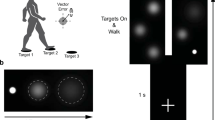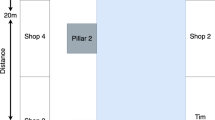Abstract
In order to fully understand how vision is used to guide locomotion it is necessary to know what people look at as they move through the environment. This study provides information, hitherto lacking, regarding gaze behaviour associated with both maintaining and changing the direction of locomotion: activities that are essential for efficient navigation through our cluttered environment. Participants’ spatiotemporal gaze patterns were recorded whilst they performed a task requiring that they either maintained a straight walking trajectory or changed their direction of walking by 30° or 60°, left or right, at the midpoint of a 9-m path. Participants were either visually cued to turn when they stepped on a trigger mat placed one step before the mid-point of the walkway (cued trials) or given verbal instruction about the required route prior to the start of each trial (advance knowledge trials). Our clear finding was that for the large majority of the time participants’ gaze was aligned with environmental features lying in their current plane of progression both prior to and following the onset of the transition stride during which the direction change was implemented. This gaze behaviour was observed both during cued trials (78% of total fixation time prior to the transition stride onset and 89% following the transition stride onset) and advance knowledge trials (67% prior to transition stride onset, 92% following transition stride onset). When not aligned with the plane of progression, gaze was normally fixated on environmental features related to either known or potential future routes. Prior to changing the direction of walking, individuals invariably made saccadic eye movements in order to align gaze with the end-point of the required travel path. This gaze realignment was invariably accompanied by head reorientation, which was initiated, on average, at the same time as the saccade. On average, participants fixated gaze on their goal (represented by the cue light at the travel path end-point) until after head realignment with the new path was achieved. Additionally, the head was consistently aligned with participants’ current walking direction prior to and following the transition stride even on the minority of occasions when they were looking elsewhere. These findings challenge the ecological validity of existing theories of how visual information is used to determine heading direction and are consistent with the proposal that aligning the head with the desired travel direction through coordinated eye and head movements provides the CNS with an allocentric frame of reference that is used to control the movement of the body in space.
Similar content being viewed by others
Author information
Authors and Affiliations
Corresponding author
Rights and permissions
About this article
Cite this article
Hollands, M.A., Patla, A.E. & Vickers, J.N. “Look where you’re going!”: gaze behaviour associated with maintaining and changing the direction of locomotion. Exp Brain Res 143, 221–230 (2002). https://doi.org/10.1007/s00221-001-0983-7
Received:
Accepted:
Published:
Issue Date:
DOI: https://doi.org/10.1007/s00221-001-0983-7




